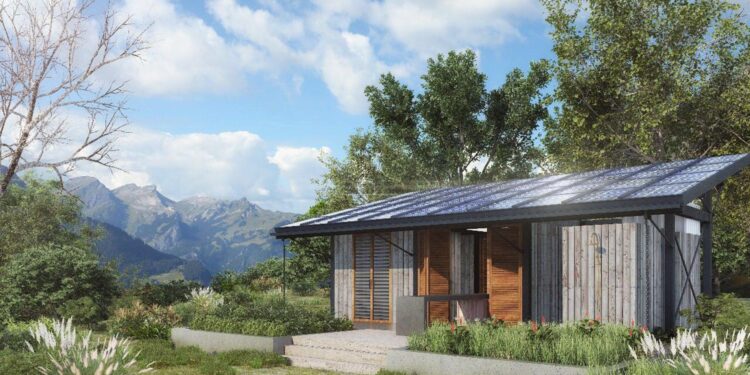ONUS Architecture Studio has unveiled an innovative net-zero residence seamlessly integrated into the rugged Cycladic terrain of Greece. The groundbreaking project exemplifies sustainable design by combining cutting-edge eco-friendly technologies with the region’s distinctive architectural heritage. Located amid the iconic whitewashed landscapes, the residence not only minimizes its environmental footprint but also resonates harmoniously with its natural surroundings. This latest work by ONUS Architecture Studio highlights a growing trend in architectural practice emphasizing resilience, energy efficiency, and cultural sensitivity in some of the world’s most challenging environments.
ONUS Architecture Studio Integrates Sustainable Design with Traditional Cycladic Elements
Nestled within the rugged Cycladic landscape, ONUS Architecture Studio has masterfully blended sustainable innovation with timeless traditional design. The residence seamlessly mirrors the island’s iconic architecture through the use of whitewashed cubic forms, flat roofs, and organic stone facades, forging a strong dialogue with the natural terrain. This approach not only preserves the aesthetic integrity of the region but also contributes to excellent thermal performance. The ground-hugging volume is carefully oriented to optimize solar gain in winter and shade in summer, demonstrating a profound understanding of the local microclimate. Native vegetation surrounding the structure further enhances natural cooling and rainwater retention.
The eco-conscious design strategy extends beyond aesthetics, incorporating an array of sustainable technologies to achieve net-zero energy consumption. Key features include:
- Photovoltaic panels integrated seamlessly into the roofscape
- Geothermal heating and cooling systems minimizing reliance on fossil fuels
- Low-impact materials sourced from local quarries and producers
- Natural ventilation pathways enhancing indoor air quality
The studio’s commitment to environmental stewardship is underscored in the performance metrics, showcased below:
| Parameter | Value | Impact |
|---|---|---|
| Energy Use Intensity | 12 kWh/m²/year | 85% reduction vs. typical local homes |
| Water Recycling Rate | 70% | Substantial reduction in freshwater demand |
| Carbon Footprint | Near-zero COâ‚‚ emissions | Aligned with global net-zero targets |
Innovative Net Zero Technologies Power Energy Independence in Remote Greek Residence
Set against the rugged Cycladic landscape, this pioneering net-zero residence by ONUS Architecture Studio exemplifies how sustainable design can seamlessly blend with local geography. Utilizing cutting-edge renewable energy systems, including high-efficiency photovoltaic panels and geothermal heat pumps, the home achieves remarkable energy autonomy despite its remote location. Strategic placement and natural shading minimize energy consumption, while a state-of-the-art battery storage system ensures uninterrupted power supply, promoting genuine energy independence in a region traditionally challenged by infrastructure limitations.
Key sustainable features incorporated in the design:
- Integrated solar energy harvesting with adaptive panel orientation
- Advanced rainwater capture and greywater recycling systems
- High-performance insulation tailored for Cycladic climate extremes
- Smart home energy management for real-time consumption optimization
- Locally sourced materials reducing carbon footprint
| Technology | Benefit | Impact on Performance |
|---|---|---|
| Solar Photovoltaics | Clean electricity generation | Supports 70% of annual energy needs |
| Geothermal Heat Pumps | Efficient heating & cooling | Reduces HVAC energy use by 50% |
| Battery Storage | Energy resilience | Enables 24/7 off-grid power |
Recommendations for Future Projects Emphasizing Environmental Harmony and Local Materials
Future architectural endeavors must prioritize a seamless integration with the natural landscape, especially in ecologically sensitive regions like the Cyclades. This approach not only preserves the inherent beauty of the environment but also enhances the sustainability of the structures. Designers are encouraged to champion the use of locally sourced materials such as native stone, wood, and traditional plaster, which not only reduce the carbon footprint associated with transportation but also ensure the buildings resonate culturally and aesthetically with their surroundings. Moreover, adopting design strategies that embrace the topography instead of altering it fosters resilience against climate challenges and maintains the ecological balance of the site.
Emphasizing these principles can be further supported through practical guidelines that future projects may adopt:
- Contextual Design: Tailoring architecture to harmonize with existing landforms and views.
- Material Transparency: Documenting material provenance and promoting recyclable or biodegradable options.
- Passive Energy Solutions: Integrating natural ventilation, solar orientation, and thermal mass.
- Community Engagement: Collaborating with local artisans and stakeholders to foster cultural continuity.
| Key Element | Recommended Approach |
|---|---|
| Terrain Adaptation | Minimize excavation; leverage slope for natural drainage |
| Material Choice | Use Cycladic stone and reclaimed timber |
| Energy Efficiency | Embed solar panels discreetly within rooflines |
| Water Management | Implement rainwater harvesting and greywater systems |
Concluding Remarks
ONUS Architecture Studio’s net-zero residence exemplifies a harmonious blend of sustainable design and sensitivity to the Cycladic landscape. By integrating advanced environmental technologies with traditional architectural elements, the project sets a new benchmark for eco-conscious living in Greece. As the demand for environmentally responsible housing grows, this innovative residence offers a compelling model for future developments in both the region and beyond. The collaboration between visionary design and natural terrain underscores the potential for architecture to contribute meaningfully to the global sustainability agenda.














![Leyla Aliyeva visits Azerbaijan National Carpet Museum [PHOTOS] – AzerNews](https://europ.info/wp-content/uploads/2025/12/3035623-leyla-aliyeva-visits-azerbaijan-national-carpet-museum-photos-azernews-120x86.jpg)

